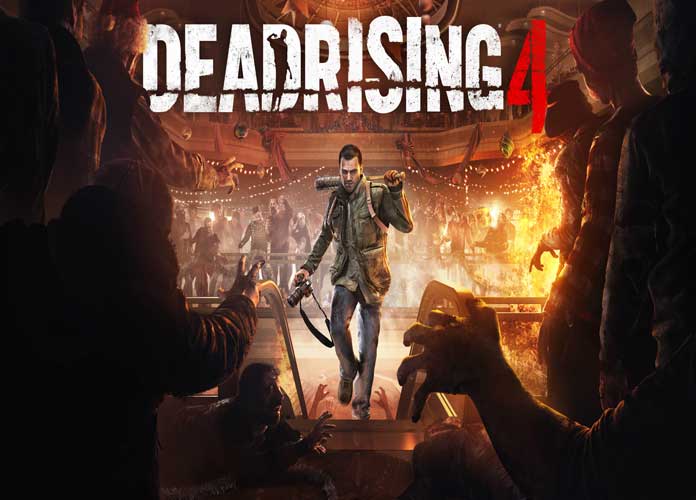‘Dead Rising 4’ Game Review: A Zombie Of Its Former Self

1.5/5
Dead Rising 4 is the fourth numbered installment in Capcom’s secondary zombie franchise. The original Dead Rising arrived on the Xbox 360 back in 2006, and it left a lasting impression, from its well-designed map to the humorous situations you’d find yourself in as you played through it.
> BUY NOW: DEAD RISING 4
Of course, much of that was centered around the game’s defining characteristic: time. Frank West, the protagonist, had three in-game days to solve the mystery, obtain his story and escape the mall with any survivors he had saved. Dead Rising’s facets, particularly Willamette’s immaculate layout, revolved around the timer, and it made playing the game rewarding, even if it isn’t a mechanic that’d be cherished by everyone. (Plus, if you could live with losing out on the story, you could still goof around and have fun.)
As I once mentioned, Hotel Dusk: Room 215 is my all-time favorite video game. I haven’t put too much consideration into what specific games follow it, but Dead Rising was one of the first to pop into my mind when I tried:
#7FaveGames? Umm…
Hotel Dusk <3
Super Mario World
Super Mario Galaxy 2
Donkey Kong Country 2
Ace Attorney 1
Pac-Man CE DX
Dead Rising— Matt Reisine (@LegendCartBoy) August 10, 2016
While the quality did drop, the second generation of the franchise – which is composed of Dead Rising 2, Dead Rising 2: Case Zero, Dead Rising 2: Case West and Dead Rising 2: Off the Record – made a conscious effort to follow the framework of the original. Notably, these were the first titles developed by Capcom Vancouver, although they were known as Blue Castle Games at the time.
While their initial titles laid the groundwork, Dead Rising 3 was a significant shift for the series. The biggest divergence was with its marginalization of the time limit, although the overall difficulty was reduced drastically, too. However, a slapdash “Nightmare Mode” was provided in an attempt to placate fans of the older, less forgiving titles.
Capcom Vancouver’s latest entry in the series, Dead Rising 4, launched on the Xbox One last month as a timed-exclusive. Its marketing emphasized the reappearance of the series’ original protagonist, and he was returning to the series’ original setting. Additionally, Capcom Vancouver sought to create a game players could enjoy without the stress of a time limit, hence the outright removal of the series’ core mechanic.
So, can Dead Rising 4 appeal to fans of the original Dead Rising, and can it otherwise prove to be an engaging sandbox experience?
First, let’s talk about our favorite everyman’s comeback. Fans will instantly notice two contradictions between Dead Rising 4’s Frank West and his prior incarnations: his voice and his design. Frank was portrayed by Terence J. Rotolo in most of his earlier appearances, but Victor Nosslo was cast as the role this time. This decision was made as the development team wanted a “grizzled, older take” on Frank. As for his physical appearance, Frank managed to age so gracefully that he not only looks younger, but his facial structure has changed.
Shortly after starting, a Dead Rising vet will discern another alteration: Frank’s personality is different. Continuity nods are made to his prior escapades, but there’s little else to link Dead Rising 4’s take on Frank to the character’s earlier incarnations beyond sharing their name, profession and hair color. There’s little in the story that persuasively required Frank to be the lead, either, so it would’ve been ideal if Dead Rising 4’s protagonist became a new character rather than mar our memories of Frank.
However, if you can overlook these discrepancies, you’ll discover that our new Frank is wholeheartedly unlikeable. He’s juvenile, his dialogue is littered with humorless quips (“That’s what she said!”), and his consideration for fellow survivors, at best, can be described as indifference, although his interactions improve slightly following a spontaneous enlightenment over halfway through the game. Nosslo’s voice work personifies the new Frank well, however.
As for the story, it’s standard Dead Rising fare on the surface: a zombie outbreak occurs, our hero needs to learn how it happened and how to stop it. Frank, who’s now working as a college professor, gets forced back on to the field. Some recurring faces factor into events, and, shockingly, Frank determines a shady conspiracy is behind the epidemic. The biggest variable is Frank’s student, Vick Chu. She serves as Frank’s rival in not only getting the scoop first but also in who can claim to be the most insufferable character.
The story – which is begins on Black Friday – is accentuated with a few pretentious overtones of American consumerism. This isn’t a new concept for Dead Rising, let alone zombie-themed media, but 4 could benefit from a little more subtly in its commentary.
Dead Rising 4 spans six in-game cases, with a short prologue kickstarting the adventure. In terms of its progression, 4 advances as its forbearers had: you’re given directions, you follow them. You’ll trek across the entire overworld in doing so, eventually reaching unmarked areas. However, for a game that encourages exploration, it’s often a chore to roam around.
Dead Rising 4’s map is an improvement over 3’s, but only barely. The new Willamette Memorial Megaplex Mall lies in the center of its surrounding suburb. The circling town is reminiscent of 3’s city, Los Perdidos, although 4’s somewhat more diverse color pallet allows Willamette to give off a more appealing aesthetic than the haphazard, generic metropolis we endured in the previous game. The Christmas theme helps, too.
Unfortunately, while the layout isn’t much of an advancement from 3, it’s made more bearable by the return of shortcuts. Upon securing safe houses from the zombies, Frank can access their tunnels to instantly enter the mall. Furthermore, there aren’t any conveniently placed roadblocks that impede you from going to your next destination.
The series tries to encourage sightseeing, and 4 continues that tradition. In addition to hidden collectables to incentivize exploring, Willamette offers random happenstances to reward players. These missions could be helping a survivor, looting a crate or abolishing a piece of equipment. Clearing these missions bestows the player with prizes, such as adding a survivor to bolster the area’s safe house. The side-quests in prior titles were far more fulfilling, however.
Dead Rising 4 endeavors to expand upon Frank’s journalistic work. Photography returns, and new investigation segments are dispersed throughout the campaign. In these, Frank must explore his surroundings with his camera and take pictures of clues. These portions are underdeveloped, but I enjoyed them for breaking up the monotony. Vick updated Frank’s camera with two new filters, both of which are indispensable during investigations, certain moments in the story and in finding all of Willamette’s hidden secrets.
The campaign is mindless in terms of its difficulty. While you can level up Frank and improve his attributes, you never need to as any sense of danger is completely absent. However, Capcom Vancouver has acknowledged this criticism, and a forthcoming update will add additional difficulty options.
As a fan request new difficulty levels are coming early in the new year. #DeadRising4 https://t.co/6vJIh4Rv7Z
— Dead Rising (@DeadRising) December 24, 2016
Finally, without giving too much away, Dead Rising 4’s sixth case was a particularly nasty way to close the game, especially since we know a DLC expansion, Frank Rising, is coming. It’s safe to assume Frank Rising will serve as Dead Rising 4’s equivalent to the series’ requisite “Overtime Mode.” There’s only one ending, too, breaking a proud franchise tradition.
Dead Rising 4 places its zombies at the forefront of the experience. Now, while I lament the loss of the timer, I recognize that it is possible to create an enjoyable zombie-killing simulator, even if that isn’t what truly defined the first Dead Rising.
However, 4’s biggest problem is something that has always remained true of the series: Dead Rising’s zombie-killing isn’t engaging over the long-term. The combat is simplistic and cannot carry a game, regardless of any new weapons and gimmicks. And while 4 does include a plethora of silly tools (many of which embody its Christmas theme), the quaint enjoyment that comes from using them won’t last for however long it takes you to finish the game. 4‘s weapons are far more homogenized than prior entries, too.
Combo Weapons, first seen in the Dead Rising 2-era, are just as effortless to obtain as they were in the previous game. Generally, you’ll find their blueprints unguarded in the open, with the necessary ingredients to build them conveniently located immediately around it. However, while they’re as easy to acquire as they were in 3, there’s less of them.
Dead Rising 4, in its effort to streamline its control scheme, locked its three weapon varieties – Melee, Thrown and Ranged – to the D-Pad’s top, left and right inputs, respectively. Health items are activated by pressing down on the D-Pad. While this allows Frank to hold three active weapons at once, it comes with a reduction in their utility.
In prior games, you could chuck most weapons, but that complementary function is now restricted to items in the Thrown category. Furthermore, in Dead Rising 3, the overpowered, cartoony tools in your artillery could have multiple methods of attack, but in 4 they’re limited to one of the three categories.
Also, in prior games, you could pick up nearly anything to use as a makeshift weapon. That interactivity was scaled down, too, as were the ways you could interact with the environment. This makes the moment to moment gameplay less kinetic, especially as a lot of the unique properties behind some of the tools have disappeared. CrowbCat recently posted an excellent video on the matter:
A lot more care was put into the world of the original Dead Rising.
The zombies themselves are somewhat more capable than they have been. They’re faster and there’s more of them, although that doesn’t translate into them being more threatening. A zombie might sneak up behind you, too, which gives you a prompt to counterattack a la the Batman: Arkham series.
If you’re encircled by the undead, the standard background music fades and is replaced with a more dramatic track. You’re also given an audio cue should a zombie sneak up behind you. These seem like nice advantages – and they can be, don’t get me wrong – but they get very laborious. You’re surrounded by zombies very frequently, so you’ll be hearing these sounds very frequently. Fortunately, a less overbearing auditory indicator occurs when you’re close to one of the many collectibles.
To their credit, Capcom Vancouver did try to spruce up enemy confrontations with two new zombie varieties: fresh zombies and evolved zombies. If a zombie was recently infected, it’ll sprint directly at you once it sees you. Evolved zombies are the most aggressive of the undead, and they’re the most capable in combat. They can dodge your attacks, too. However, while the attempt at variability is nice, the new types aren’t more complicated to dispatch, they’re simply more annoying to fight against. Additionally, human adversaries, including soldiers and looters, run amok. They aren’t more resilient than the undead, either.
When you’re out in the open, it’s usually easy enough to circumvent the zombies and the repetitive act of hitting them. However, often enough, Frank gets trapped in a closed environment that dictates him to clear out the zombies (or soldiers) contained within before he can move on. These segments aren’t merely a test of Frank’s endurance, they’re also one of the player’s patience.
https://www.youtube.com/watch?v=dfiC_Jya514
Psychopaths, boss characters, provided some of the most memorable encounters in the previous games, even potentially providing players with an interesting altercation. Now, they’ve been replaced with Maniacs. The former had their own personal narratives which discussed their place in the outbreak and why they lost their grip on reality. Conversely, Maniacs have little to distinguish them from the other enemies barring perhaps a very brief monologue where they taunt Frank.
Dead Rising 4’s biggest contribution to its series is its EXO Suit. Upon clearing the first chapter, Frank can find these armors at specific spots. Donning one sacrifices some mobility for additional combat prowess, but the suits accentuate Frank’s strength immensely. Items that’d be too heavy for an undecorated Frank, such as a parking meter, can be handled in an EXO Suit. Moreover, Frank can stylize his Suit with improvised power-ups, such as an arcade machine, to grant him extra abilities. There are portions of the campaign that require Frank to wear an EXO Suit, although they’re as arduous as every other time Dead Rising 4 forces you into fisticuffs.
While its frame rate is generally a consistent 30 FPS, glitches plague Dead Rising 4. You’ll sometimes get stuck within parts of the environment, which led to a memorable moment when half of Frank’s torso was protruding from a truck and he was defenseless against a squad of looters. A couple of times while playing, I was kicked from the game to the Xbox Marketplace unprovoked, and my Xbox One shut off the first time I tried to load Dead Rising 4. There’s a glaring lack of polish.
An online multiplayer mode, which is stricter than the main game, is included too, but it won’t hold your attention for long. Here, up to four players can cooperate to survive waves of zombies. Notably, the playable characters in this mode are present in the main story.
Dead Rising 4 is passable at its best in terms of graphics, awkward animations and models aside, and the Christmas decorations add a pleasant veneer to the otherwise generic setting. The holiday backdrop assists the soundtrack, too, with several festive, jazzy songs to spice up Willamette, even if you won’t always hear them over the zombies. Honestly, Dead Rising 4’s OST is probably my favorite aspect of the game. An appreciated aural callback is made in the mall, where you can intermittently hear the original Dead Rising’s mall themes.
Dead Rising was defined by many things, including its timer, dynamic interactivity and difficulty. Dead Rising 4 abandoned all of that and substituted it with nothing, rendering it a repetitive, shallow shadow of its ten-year-old forbearer. Nevertheless, you can have some nominal fun with 4 if you want to play around in a zombie-filled sandbox.
However, the pleasure in doing so won’t hold up for extended sessions. Dead Rising 4 isn’t merely a regression for its series, it’s an inadequate experience all-around. There’s no urgency to drive you, the map and skirmishes aren’t satisfying and the campaign is mind-numbing.
According to an interview with executive producer Bryce Cochrane and studio head Joe Nickolls, one of their goals with Dead Rising 4 was “to really make a product that means we can make Dead Rising 5, 6, 7.” If Capcom Vancouver continues down the path set by Dead Rising 3 and 4, then the quality of those sequels will prove to be more terrifying than any zombie outbreak.
1 Comments
Leave a comment
RELATED ARTICLES
Get the most-revealing celebrity conversations with the uInterview podcast!








Pingback: Character Chronicle: Frank West – Source Gaming